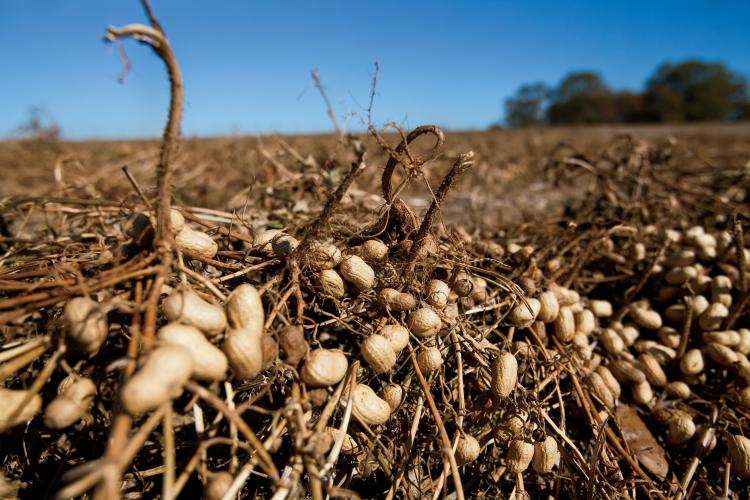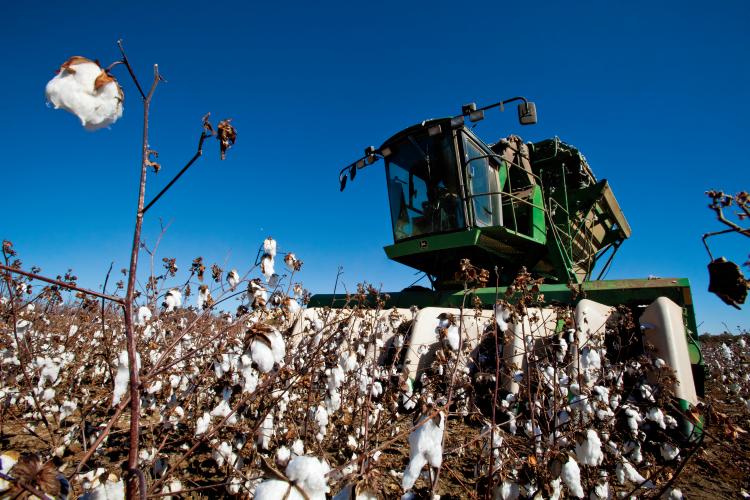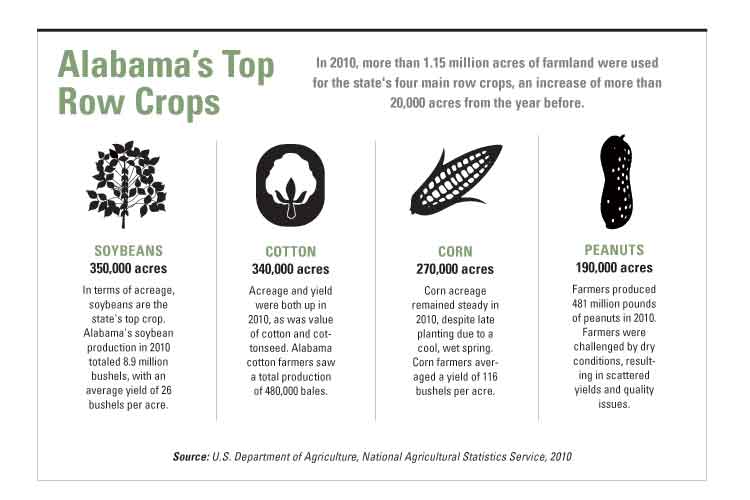Home > Alabama > Alabama Crops & Livestock > Peanut Crop Rotation Benefits Cotton and Alabama Economy
Peanut Crop Rotation Benefits Cotton and Alabama Economy

Last year, Alabama farmers harvested more than 480 million pounds of peanuts on 185,000 acres of farmland. The production from just one of those acres translates into 30,000 peanut butter sandwiches, which in economic terms is hardly peanuts.
In fact, according to Randy Griggs, executive director of the Alabama Peanut Producers Association, the peanut industry generates more than $100 million per year for the Alabama economy and has an overall economic impact of between $400 and $500 million.
Much of that success is a result of the climate, the soil, and the rich tradition of peanut farming in southern Alabama, specifically in the Dothan area. With nearly half of the U.S. peanut crop produced within a 100-mile radius of the city, Dothan has earned its nickname as “The Peanut Capital of the World.”
From King Cotton to Premier Peanut
Alabama’s success in developing and sustaining peanut production is rooted in both practicality and science. In the 1800s, cotton was king; however, in the early 1900s the crop was devastated by a boll weevil epidemic and by practices of repeated cotton plantings, which depleted the soil. Alabamians, urged on by the research of George Washington Carver, turned to peanuts as an alternative.
Carver, who headed the Department of Agriculture at the Tuskegee Institute, promoted peanuts not only as a food source but as a basic ingredient in nearly 100 products including cosmetics, dyes, paints and plastics. In addition, he, along with other agricultural experts, encouraged farmers to implement a crop rotation system as a way to improve their soil, increase their cotton yields and provide an alternative cash crop.
The science behind crop rotation centered on restoring nitrogen to the soil, which becomes depleted when cotton is planted year after year. By alternating cotton with peanuts or other soil-enriching legumes, such as sweet potatoes or soybeans, cotton crops improved.

Yielding Results
What started as a way to boost cotton production has turned into a boom for peanut producers as well. According to Kris Balkcom, a research associate at Auburn University and a peanut specialist, “Crop rotation is the key to high peanut yields because it breaks the cycles of plant disease and pests” that are common when the same crop is planted year after year. He suggests a three-year rotation, two years of cotton and one of peanuts. By rotating the crops, farmers discourage the nematode population, a pest that feeds on peanuts but not on cotton, thus improving peanut yields, he explains.
So both crops – and the Alabama farmers who grow them – benefit. Currently, Alabama is second only to Georgia in peanut production, and with nearly 480,000 bales of cotton harvested each year, Alabama ranks 10th in U.S. cotton production.
Benefits to the state extend beyond the direct financial impact of a crop’s market value as well, with textile mills and peanut processing plants also impacting Alabama’s economy in terms of dollars and employment opportunities. A new peanut butter manufacturing facility, for instance, is set to open in Troy creating 130 new jobs for the local economy.
With such proven success, why would farmers not follow crop rotation practices? Balkcom says it’s about trying to capture the highest crop prices, a practice he discourages.
“My advice is not to chase after the price but to follow the science,” he says. “In the long haul the steady high yields will be better than riding the price roller coaster.”

Farm Facts About Peanuts
According to the National Peanut Board, the average American consumes nearly six pounds of peanut butter and peanut products each year. Alabama plays a prominent role in producing much of it. The next time you take a bite of a peanut butter sandwich consider these facts:
• Four varieties of peanuts are grown in the United States: Runner, Virginia, Spanish and Valencia. In Alabama, 95 to 98 percent of the peanuts grown are runners, and nearly half of them are used to produce peanut butter.
• It takes about 540 peanuts to make a 12-ounce jar of peanut butter.
• By law, peanut butter must be at least 90 percent peanuts.
• Americans spend almost $800 million on peanut butter each year.
• The peanut is not a nut, but a legume related to beans and lentils.
• Peanuts and peanut butter contain more than 30 essential nutrients and phytonutrients.




What percentage of these rotationally oriented farms are organic – both in the cotton growing as well as the peanuts?
I look forward to a reply ~ with thanks!
What percentage of these rotationally oriented farms are organic – both in the cotton growing as well as the peanuts?
I look forward to a reply ~ with thanks!
What percentage of these rotationally oriented farms are organic – both in the cotton growing as well as the peanuts?
I look forward to a reply ~ with thanks!